- Chemical Name:Ceramide 4
- CAS No.:100403-19-8
- Molecular Formula:C24H47NO3
- Molecular Weight:397.63488
- Hs Code.:
- UNII:SF3LP91341
- DSSTox Substance ID:DTXSID70420650
- Nikkaji Number:J648.535I
- Wikidata:Q27289174
- Metabolomics Workbench ID:156945
- Mol file:100403-19-8.mol

Synonyms:C4 Ceramide;Ceramide 4;74713-58-9;Ceramide as (ceramide 4);Ceramide 4 (retired) [INCI];N-Butyryl-D-erythro-sphingosine;Ceramide as (ceramide 4) [INCI];N-[(E,2S,3R)-1,3-dihydroxyoctadec-4-en-2-yl]butanamide;UNII-SF3LP91341;SF3LP91341;Butanamide, N-((1S,2R,3E)-2-hydroxy-1-(hydroxymethyl)-3-heptadecen-1-yl)-;Butanamide, N-(2-hydroxy-1-(hydroxymethyl)-3-heptadecenyl)-, (R-(R*,S*-(E)))-;C4 Ceramide (d18:1/4:0);CERAMIDE AS;SCHEMBL14032269;DTXSID70420650;AKOS037645030;AS-56315;BP-28806;CS-0455461;N-Butyryl-D-sphingosine, >=98.0% (TLC);Q27289174;N-((2S,3R,E)-1,3-dihydroxyoctadec-4-en-2-yl)butyramide;C4 Ceramide (d18:1/4:0), N-butyroyl-D-erythro-sphingosine, powder


